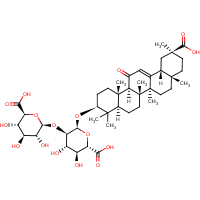Glycyrrhizin
Agent Name
Glycyrrhizin
CAS Number
1405-86-3
Formula
C42-H62-O16
Major Category
Biological Agents

Synonyms
(3beta,20beta)-20-Carboxy-11-oxo-30-norlean-12-en-3-yl-2-O-beta-1- 7-glucopyranuronosyl-alpha-D-glucopyranosiduronic acid; alpha-D-Glucopyranosiduronic acid, (3beta,20beta)-20-carboxy-11-oxo-30-norlean-12-en-3-yl-2-O-beta-1-7-glucopyranuronosyl-; 18-beta-Glycyrrhizic acid; 20beta-Carboxy-11-oxo-30-norolean-12-en-3beta-yl-2-O-beta-D-glucopyranuronosyl-alpha-D-glucopyranosiduronic acid; Glycyron; Glycyrrhetinic acid glycoside; Glycyrrhizic acid; Glycyrrhizinic acid; Liquorice; Rizinsan K2 A2 (free acid); alpha-D-Glucopyranosiduronic acid, (3beta,20beta)-20-carboxy-11-oxo-30-norolean-12-en-3-yl-2-O-beta-D-glucopyranuronosyl-; [ChemIDplus]
Category
Plant Toxins
Description
Solid with intensely sweet taste; [Merck Index] Crystalline plates or prisms; [MSDSonline]
Sources/Uses
The active principle extracted from licorice root; Used as a humectant in tobacco and as a flavor in confectionery and pharmaceuticals; [Hawley]
Comments
Emergency treatment: "Liquorice"; "Hypokalemia, hypernatremia, and water retention are primary problems associated with chronic liquorice ingestion." Glycyrrhizin is the major active compound (triterpene glycoside) in licorice root. It has been used as an herbal remedy for ulcers, inflammation, and viral infections. After ingestion and hydrolysis, the compound inhibits an enzyme that results in increased serum cortisol levels. [Haddad, p. 485] No adverse effects in the majority of adults expected at doses <100 mg/day; A high intake of liquorice confectionery or herbal tea may exceed 100 mg/day; [JECFA]
Biomedical References
Exposure Assessment
Diseases, Processes, and Activities Linked to This Agent
Other Information
No other related information on this agent was found.